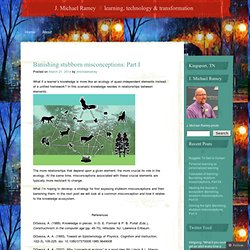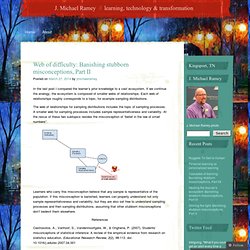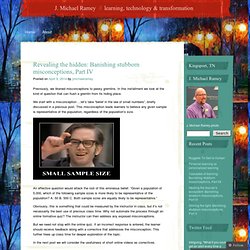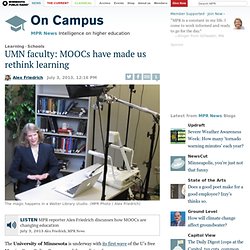

Banishing stubborn misconceptions: Part I. What if a learner’s knowledge is more like an ecology of quasi-independent elements instead of a unified framework?

In this scenario knowledge resides in relationships between elements. The more relationships that depend upon a given element, the more crucial its role in the ecology. At the same time, misconceptions associated with these crucial elements are typically more resistant to change. What I’m hoping to develop: a strategy for first exposing stubborn misconceptions and then banishing them. In the next post we will look at a common misconception and how it relates to the knowledge ecosystem. References DiSessa, A. (1988). DiSessa, A. DiSessa, A.
Disessa, A., Gillespie, N., & Esterly, J. (2004). Özdemir, G., & Clark, D. Like this: Like Loading... Banishing stubborn misconceptions: Part II. In the last post I compared the learner’s prior knowledge to a vast ecosystem.

If we continue the analogy, the ecosystem is composed of smaller webs of relationships. Each web of relationships roughly corresponds to a topic, for example sampling distributions. The web of relationships for sampling distributions includes the topic of sampling processes. A smaller web for sampling processes includes sample representativeness and variability. At the nexus of these two subtopics resides the misconception of “belief in the law of small numbers”. Learners who carry this misconception believe that any sample is representative of the population. References Castrosotos, A., Vanhoof, S., Vandennoortgate, W., & Onghena, P. (2007). Chance, B., DelMas, R., & Garfield, J. Banishing stubborn misconceptions: Part IV. Previously, we likened misconceptions to pesky gremlins.

In this installment we look at the kind of question that can flush a gremlin from its hiding place. We start with a misconception …let’s take “belief in the law of small numbers”, briefly discussed in a previous post. This misconception leads learners to believe any given sample is representative of the population, regardless of the population’s size.
An effective question would attack the root of this erroneous belief. “Given a population of 5,000, which of the following sample sizes is more likely to be representative of the population? Obviously, this is something that could be measured by the instructor in class, but it’s not necessarily the best use of precious class time. But we need not stop with the online quiz. In the next post we will consider the usefulness of short online videos as correctives. Like this: Like Loading... Cascades of learning: Banishing stubborn misconceptions, Part VII. Over the past seven weeks we’ve looked at misconceptions and how they can hide in the learner’s ecosystem.

We’ve also looked at how to expose these gremlins and then banish them. A particularly effective method of exposing the gremlins is by deploying online formative assessments. Students are made aware of their misconceptions as a prelude to instructional intervention. The instructor can then intervene directly, or better, attempt to banish the misconception through a multimedia intervention prior to direct instructional time. To be effective, the intervention needs to conform to principles of multimedia learning: audio and video content need to harmonize; segments should be 3-5 minutes in length; and the tone should be conversational. If the multimedia intervention does its appointed work, the learner is set free to learn more deeply as ripples of new understanding course through the conceptual ecosystem. The end goal is that more of our students are empowered to learn more deeply. UMN faculty: MOOCs have made us rethink learning. The magic happens in a Walter Library studio.

(MPR Photo / Alex Friedrich) Listen MPR reporter Alex Friedrich discusses how MOOCs are changing education July 3, 2013 Alex Friedrich, MPR News The University of Minnesota is underway with its first wave of the U’s free Massive Open Online Courses, and the verdict so far: It’s a lot of work. But professors are awed by the sheer reach their words have. And when they bring thousands of students and experts from all over the world to talk about their subject, the discussion takes on a life of its own. “It has been amazing,” said Jason Hill, who teaches Sustainability of Food Systems: A Global Life Cycle Perspective to more than 25,000 students from more than 130 countries.
More than 70,000 students have enrolled in the five courses — known as MOOCs — in the fields of science, health and medicine. With such tools, MOOC advocates say, one professor can bring university-level education to tens of thousands of people around the world. Assessing Important Learning Outcomes in Introductory Tertiary Statistics Courses - Assessment Methods in Statistical Education: An International Perspective - Garfield. Overview of Conceptual Change Theories.
Power_of_Feedback_JHattie.pdf. Cognitive Theory of Multimedia Learning.